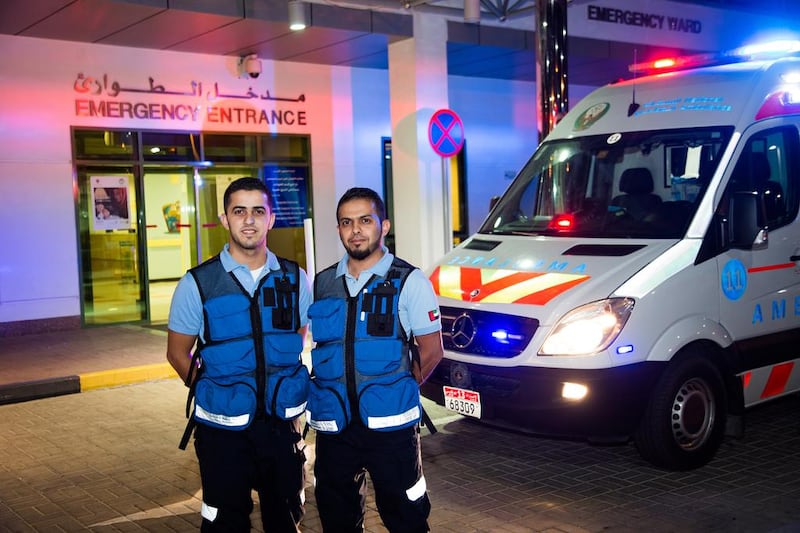On a typical shift in the Northern Emirates, emergency medical technicians are on constant alert. Mohammad Rawashdeh, the EMT team leader for the National Ambulance Service in Ajman, has opened his diary to show what he and his colleagues face on a given day
5pm: I arrive at the main station in Ajman. The ambulance crew from the previous shift gives us an update on how their shift went. After that, my partner and I do a full inspection of the ambulance to ensure all is in place and we are ready to respond.
7.10pm: We receive a call about a patient who is unconscious. We immediately mobilise and set off to the location.
7.15pm: We arrive to find an Emirati woman who is feeling dizzy and unable to move. Her blood pressure and blood sugar levels are high. She reveals she suffers from chronic hypertension and is diabetic. We explain she needs to see a doctor for an immediate check-up and so will transport her to the nearest hospital. We then put her on the stretcher.
7.30pm: On our way to the hospital where we do an ECG (electrocardiogram) and assess her vital signs.
7.38pm: We arrive at the hospital where we hand the patient to the hospital crew.
11.24pm: We receive a call about a critical case of a one-year-old baby who is suffering from severe shortness of breath inside an Ajman hotel room.
11.32pm: We are received by the hotel staff, who immediately lead us to the patient’s room. The parents do not speak a word of English, adding to the sense of urgency. We ask the hotel to find someone who can help with translation. This is critical so we can gather as much information about the patient as possible.
11.34pm: The baby is crying non-stop, has shortness of breath, wheezing sound in his lungs and his lips are blue. He is unable to breath and his patient history reveals that he had been suffering from asthma attacks. His oxygen levels in the blood are very low so to calm him down I put him in his mother’s arms while my partner gives him the required medication. After seven minutes, the baby’s condition starts to improve and the oxygen levels reach the normal rate. I carry the baby in my arms to the ambulance. Both his parents come with us and we try our best to keep them calm.
Midnight: We arrive at the hospital where the staff have already been briefed. We hand the baby over for further assessment. Through the translator, the parents tell us they are extremely thankful. This is their first time in the UAE. The father holds out some money in his hand as if to pay for the service, but we tell him that there is no need as the ambulance service is provided free of charge to those visiting the UAE, as well as Emiratis and residents. He is delighted at this news.
1.55am: We are dispatched to a critical case involving a 50-year-old Emirati patient suffering from Hepatitis B and complaining about general body weakness with difficulty in breathing.
1.59am: We arrive to find a patient in a state of panic. He is shivering and excessively sweating. His body is very cold and he has abdominal swelling.
2am: Patient is upset and angry at his friend for calling the ambulance. He refuses to cooperate or allow us to take him to hospital. He starts shouting, acting aggressively and even kicks us out of the house. We insist on holding our ground, we cannot just leave him. We know that his life is on the line and it is our duty to save him. Finally, after 30 minutes of convincing, he agrees to cooperate. When we check him, his vital signs reveal hypotension and low blood oxygen.
2.30am: We finally manage to pick him up and put him on the stretcher and transfer him to the ambulance. We attach an oxygen mask to his face, put him in the shock position and attach an automated external defibrillator.
2.38am: The patient suddenly goes unconscious and becomes unresponsive. At that point, he is no longer breathing and there is no pulse. We immediately start CPR while attaching Lucas (a chest compression system).
2.43am: Arrive at the hospital. The patient is still unconscious with no pulse or breathing but we continue to give CPR. The hospital staff are waiting and we hand over the patient. However, we remain at the scene and work together to save the patient.
2.58am: The patient’s circulation spontaneously returns. Everyone is so happy. It is such a good feeling when you return a pulse.
3.20am: We drive to the station.
5am: We hand over to the morning shift crew and go home to get some rest after a long day.
newsdesk@thenational.ae






